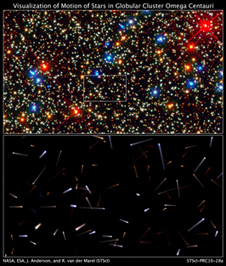One of the largest globular clusters in the Large Magellanic Cloud

This new Hubble image of NGC 1783, taken with the Advanced Camera for Survey (ACS), shows the typical shape of young globular clusters viewed during the human journey to the beginning of space and time. Image credit NASA.
Space news (September 20, 2015) – 160,000 light-years from Earth toward the constellation Dorado –
Held in the grip of its own gravity, globular cluster NGC 1783 orbits the Milky Way as part of the Large Magellanic Cloud, a region of space filled with star-forming regions like the Tarantula Nebula and LHA 120-N 11.
Lying in the southern hemisphere constellation Dorado, the typical symmetrical form and dense collection of suns near the center of NGC 1783 was first recorded by John Herschel around 1835.
Astrophysicists studied the color and brightness of individual suns within globular cluster NGC 1783 to estimate its age and history of star formation. Measurements indicate that despite its typical distribution of stars and shape this larger star cluster is only about 1.5 billion years old and during its lifespan has undergone at least two-star forming periods separated by 50 to 100 million years. Typically globular clusters viewed are several billion years of age.
The highs and lows of star formation in a globular cluster gives astrophysicists an indication of the density of gas available for new stars to form during its life span. During periods when dense gas is available for star formation, the most massive stars explode as supernovae, blowing away the gas needed for new stars to form. The reservoir of gas for new star formation is then replenished by less massive stars which live longer and die less violently. Once the reservoir of gas flows to denser, central regions of a star cluster, the second phase of star formation takes place, and a massive star with a short life spans once again blow off the gas. Astrophysicists think this cycle continues until the gas leftover can no longer sustain the formation of new stars.
Learn more about the formation of new stars here.
Discover NASA’s space mission here.
Journey to the beginning of space and time using the Hubble Space Telescope here.
Read more about galactic nurseries found during our journey.
Learn about New Horizons Visit to Pluto and its moon Charon.
Learn more about the star systems discovered during our trip through the cosmos.



